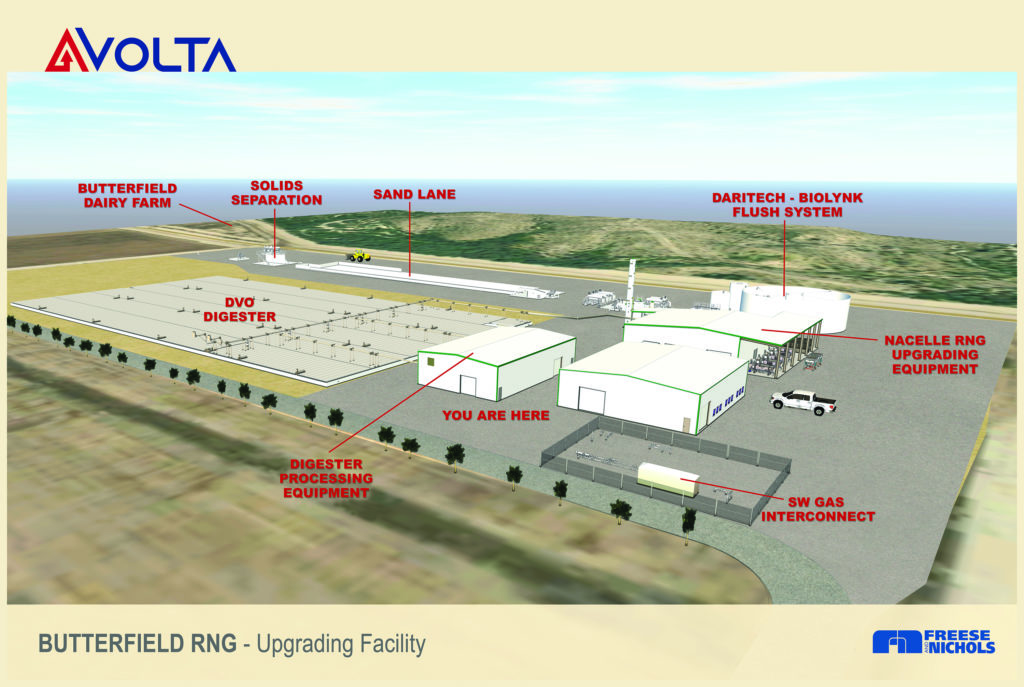Dairy Projects Help Turn Waste into Renewable Fuel
Cow manure might be a natural byproduct of dairy farming, but it isn’t environmentally friendly due to the greenhouse gases released as it decomposes. But capturing and converting the waste to renewable natural gas (RNG) is fueling a new and growing industry.
One of the latest examples of turning manure into energy is the Butterfield Dairy outside Phoenix, Arizona. The facility, housing 25,000 cows, is converting its waste collection mechanism from a freshwater flush system to a recycle flush system that will feed a digester and turn the waste into biogas. After further upgrading, it becomes RNG.
RNG from dairies is delivered to the West Coast market where cities are working to become carbon neutral – or it is sold to other locations where it can serve as a carbon offset to areas such as California.

Freese and Nichols is applying its vast experience with oil and gas facilities to help Butterfield and dairies across the United States turn tons of waste into a product that benefits the environment by reducing greenhouse gases and creates an additional revenue stream for our clients and America’s dairy farmers. In addition to reducing greenhouse gases, the dairies can considerably reduce their freshwater consumption.
The projects call on our teams’ expertise in oil and gas, treatment and numerous other fields, from pipeline hydraulics to environmental site assessment. As a design partner on the Butterfield project, Freese and Nichols is handling all civil, structural, architectural, electrical, mechanical process, controls design, construction administration and permitting for the facility.
Our experience in biogas, wastewater, manure management, gas treating, gas pipelines, CNG terminals, SCADA, federal water and air permitting, and archaeological/environmental site assessment give our staff the know-how to design and integrate the processes needed for all five phases of a biogas facility:
- Manure management
- Anaerobic digestion
- Gas upgrading
- Compression
- Pipeline
Avolta, the developer of the Butterfield Dairy RNG plant, also is developing a plant at Milky Way Dairy, a facility 20 miles away in Maricopa County housing another 35,000 cows. Read about the ground-breaking for the Butterfield Dairy project.
These are the main steps involved in the RNG conversion process:
- Manure from a dairy’s cow barns is collected and swept into manure handling facilities.
- From these facilities, the waste is processed and pumped into an anerobic digester to extract the biogas.
- Raw biogas is transferred through a gas treating system (an upgrader) to remove CO2, water and other contaminants.
- The RNG is compressed and transported by truck a short distance to a gas pipeline terminal or directly injected into a gas pipeline if one is nearby.
- The solids not converted to RNG from the anaerobic digestion process can be dried for reuse as animal bedding at the dairy and as an environmentally friendly fertilizer on crops.

Freese and Nichols is assisting dairies in multiple states with RNG projects.
The U.S. Environmental Protection Agency counts more than 270 manure-based anaerobic digestion systems operating in the United States, most of them involving dairy farms. As many as 8,000 large dairy and hog farms could adopt this method of helping reduce methane emissions. In 2020, these projects reduced greenhouse gas emissions by 5 million metric tons of CO2 equivalent and generated the equivalent of about 1.46 million megawatt-hours of energy.
To learn more about Freese and Nichols’ expertise on dairy farm RNG, contact Carey Sullivan, carey.sullivan@freese.com or 832-844-3857.

